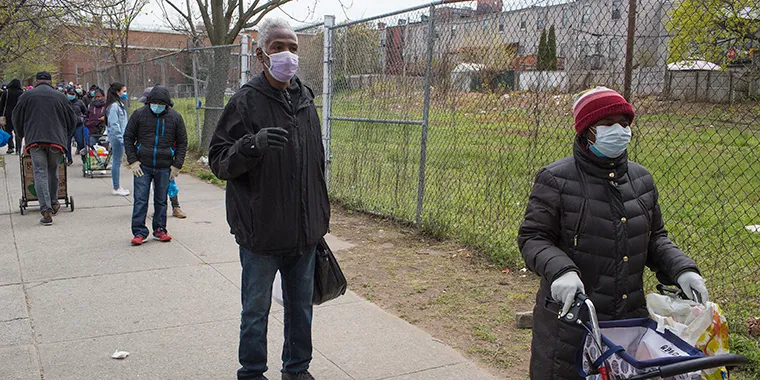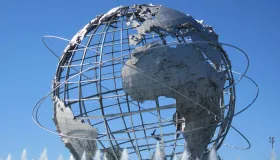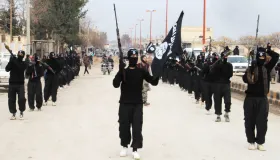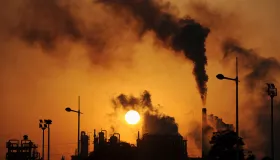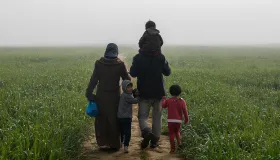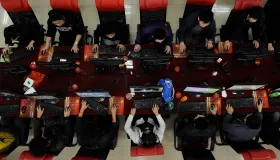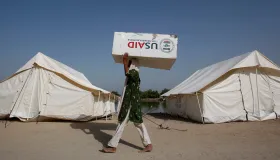COVID-19’s Unequal Consequences
In its first few months, the pandemic disproportionately harmed people of color in the United States.
Teaching Resources—Global Health: Introduction (including lesson plan with slides)
Higher Education Discussion Guide
When powerful political leaders, professional athletes, and even famous actors like Tom Hanks caught the novel coronavirus in 2020, many observers called COVID-19 a “great equalizer.”
But in the United States and around the world, it quickly became clear that this was not the case. Among the country’s three largest racial and ethnic groups (white, Black, and Hispanic/Latino), the Black and Hispanic/Latino communities faced disproportionate effects, including higher infection and mortality rates from COVID-19 and a greater likelihood of job loss.
This resource examines how generations of discriminatory laws, customs, and institutions—also known as systemic racism—drove a deadly and costly pandemic for Black and Hispanic/Latino communities in the United States and unearthed long standing inequalities.
Disparate Outcomes
It’s a centuries-old problem that the United States’ health-care system produces vastly different outcomes on the basis of race and ethnicity. As an old saying goes: “When white America catches a cold, Black America gets pneumonia.” This problem took on new urgency when COVID-19 reached the United States.
By August 2020—five months after the World Health Organization declared COVID-19 a global pandemic —Black Americans had contracted the novel coronavirus 2.6 times more often than white Americans. Hispanic/Latino Americans faced almost triple the risk of infection.
Perhaps most striking, however, has been the deadliness of this virus for communities of color. In August 2020, Hispanic/Latino Americans had a slightly higher risk of dying from the coronavirus compared to their white counterparts, while Black Americans faced more than twice that risk.
The COVID-19 pandemic has also caused a particularly devastating economic crisis for Black and Hispanic/Latino communities. Not long after the pandemic’s onset in April 2020, more than six in ten Hispanic adults reported they or someone in their household had experienced a job loss or taken a pay cut because of the pandemic. About 44 percent of Black adults and 38 percent of white adults reported the same.
What Drives Different Outcomes?
For generations, systemic racism has driven unequal access to housing, wealth, education, and health care for communities of color in the United States. This disparity has led to a pandemic that is deadlier and costlier for Black and Hispanic/Latino Americans. Let’s examine how.
Housing: People of color are more likely than white Americans to live in densely populated areas, partly due to a discriminatory federal housing policy known as redlining. From the 1930s to 1960s, redlining deemed Black and other minority neighborhoods “hazardous” for investors, resulting in deliberate underdevelopment and underinvestment in those communities. This discrimination allowed many white Americans to move into more affluent suburbs while excluding people of color.
Today, the legacy of redlining can still be seen in how COVID-19 has torn through minority neighborhoods. These communities face a host of challenges, including crowded living conditions, higher rates of air pollution, and fewer grocery stores with healthy food options. These and other such factors contribute to Black and Hispanic/Latino Americans facing higher rates of high blood pressure, obesity, and diabetes—which can make COVID-19 even more dangerous. About 90 percent of people hospitalized with coronavirus in March had one of these or similar preexisting conditions.
Wealth: Generations of systemic racism have contributed to massive wealth disparities in the United States. At the end of 2019, white Americans’ median household wealth is $189,100 compared to $36,050 for Hispanic/Latino Americans and $24,100 for Black Americans.
Homeownership is one of the most important mechanisms for accumulating wealth, but the legacy of redlining has contributed to a lasting devaluation of Black-owned property. In fact, homes in mostly Black neighborhoods were valued 23 percent lower than homes in neighborhoods with few Black residents in 2018.
With less accumulated wealth and higher rates of wage and job loss due to COVID-19, Black and Hispanic/Latino Americans are particularly economically vulnerable in the pandemic. In April 2020, they were less likely than their white counterparts to have enough financial savings to cover emergency expenses.
Occupation: COVID-19 split the American workforce in two. Some jobs allowed employees to work from home, while others required staff—deemed essential workers—to continue coming in person. Black and Hispanic/Latino Americans are disproportionately represented across several frontline industries, including public transit and building cleaning services, in which they risk exposure to COVID-19. At the same time, Black and Hispanic/Latino workers have also been more vulnerable to layoffs during the pandemic.
This dual employment crisis—higher rates of exposure to COVID-19 and greater vulnerability to layoffs—compounds existing wage inequities for Black and Hispanic/Latinx Americans. Even in comparable positions, Black and Hispanic/Latino Americans earn less than white employees. Those disparities are even starker when factoring in gender: Black and Hispanic/Latinx women make about 64 cents to every dollar white men make. They also faced the two highest unemployment rates in the country in May in what some analysts have called a “shecession,” for the gendered split in joblessness.
Furthermore, employment opportunities are often related to educational attainment. About half of Americans with college degrees can do their jobs from home during the pandemic, compared to just 4 percent of those who did not graduate from high school. Systemic racism has limited minority educational attainment for generations. Students of color are more likely than white students to attend overcrowded and underfunded K–12 schools and to face difficulties paying for college. Disparities like these mean Black and Hispanic/Latino adults are significantly less likely to hold bachelor’s degrees than their white counterparts.
Health Care: Black and Hispanic/Latino Americans experienced discrimination and received lower-quality health care well before COVID-19. The United States has a long history of conducting medical experiments on people of color, contributing to a deep legacy of distrust among these communities toward the medical establishment. Today, those Americans still struggle to access culturally competent care in their native languages at often under-resourced hospitals. Discrimination remains a dangerous barrier to care; one 2017 study showed that doctors’ bias toward white patients led to increased odds they received treatment for heart attacks compared to Black patients. A similar pattern has emerged around access to coronavirus testing, which media reports suggest is more available in whiter neighborhoods. And in New York City, hospital patients in some lower-income neighborhoods—often minority and immigrant communities—faced fatality rates ten times higher than those in the city’s wealthiest neighborhoods during the worst months of the pandemic.
Meanwhile, Black and Hispanic/Latino people are less likely to be insured than their white counterparts. In 2018, only 5 percent of white Americans were uninsured compared with 18 percent of Latino/Hispanic Americans and 10 percent of Black Americans.
Incarceration: The United States imprisons more people than any other country in the world, with Black and Hispanic/Latino individuals composing the majority of the incarcerated population. In 2018, Black Americans made up 13 percent of the U.S. population, and Hispanic/Latino Americans made up 19 percent, but these two groups account for 33 percent and 23 percent of the U.S. prison population respectively. Black Americans are more than five times likelier than white Americans to be incarcerated due in part to racial bias in policing and the criminal justice system. Black Americans, for example, face higher rates of arrest for drug violations than their white counterparts despite similar rates of drug use across race and ethnicity.
Prisons and jails are particularly dangerous during COVID-19, as social distancing in those facilities can be impossible. Mask policies are inconsistent, and in some places hand sanitizer can even be banned due to its alcohol content. By September 2020, in the United States, prisons, jails, and correctional facilities accounted for the fifteen largest clusters of virus outbreaks, with some facilities reporting around 65 percent of inmates testing positive for the virus.
Challenges of the Past, Challenges of the Future
COVID-19 is not a “great equalizer.” Its disproportionate health and economic effects on minority communities have had devastating consequences. By June 2020, nearly one-third of Black Americans and 17 percent of Hispanic/Latino Americans knew someone who had died of the virus, compared to less than one in ten white Americans.
This crisis is also particularly severe among indigenous communities, in which mortality rates were 3.5 times higher than for white Americans across nearly two dozen states as of July 2020.
Systemic racism reinforced through the centuries has brought the United States to a moment in which communities of color are doubly challenged by a deadly virus that has robbed many of both their health and employment.
